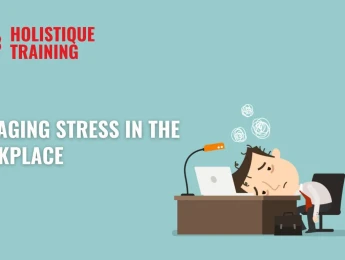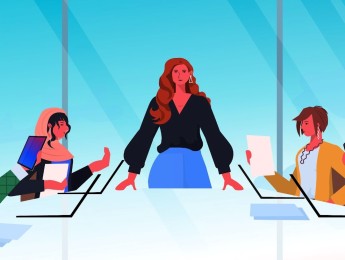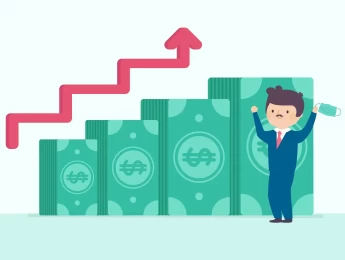- Table of Contents
- Introduction
- What is Burnout in the Workplace?
- What is Psychological Distress in the Workplace?
- What Are the Symptoms of Work-Related Stress?
- Physical Symptoms:
- Emotional Symptoms:
- The Top 10 Causes of Stress at Work
- Strict Deadlines:
- Workload:
- Poor Managers:
- Bullying and Harassment:
- Work-Related Changes:
- Role Uncertainty:
- Toxic Workplace Culture:
- Poor Communication:
- Financial Worries:
- Work-Life Balance:
- How to Address Stress at Work as a Manager
- Foster Open Communication:
- Set Realistic Goals and Expectations:
- Provide Adequate Resources and Support:
- Encourage Work-Life Balance:
- Recognise and Address Burnout Early:
- Create a Positive Work Environment:
- Encourage Professional Growth and Development:
- Offer Flexibility and Autonomy:
- Implement Stress-Reduction Programs:
- Address Organisational Stressors:
- How to Prevent Burnout as an Employee
- Set Boundaries and Learn to Say No:
- Prioritise Self-Care:
- Practice Mindfulness and Stress Management Techniques:
- Stay Organised and Manage Your Time Effectively:
- Seek Support and Build a Strong Support Network:
- Take Regular Breaks and Use Your Vacation Time:
- Foster a Positive Work Environment:
- Develop a Growth Mindset:
- Communicate Your Needs and Advocate for Yourself:
- Focus on Purpose and Meaning in Your Work:
- Conclusion
Introduction
Workplaces are dynamic environments with challenges that can push employees to excel and grow. However, these challenges can also contribute to stress, a common issue that affects employees at all levels. If not managed effectively, stress in the workplace can lead to severe consequences such as burnout and psychological distress, which can undermine an individual’s well-being and productivity. Recognising the symptoms and causes of work-related stress is the first step toward creating a healthier work environment. In this post, we’ll explore the concepts of burnout and psychological distress, identify common stressors in the workplace, and offer practical solutions for both managers and employees to mitigate and prevent these issues.
What is Burnout in the Workplace?
Burnout is a state of emotional, physical, and mental exhaustion caused by prolonged and excessive stress. It occurs when an individual feels overwhelmed, emotionally drained, and unable to meet constant demands. As the stress continues, the individual begins to lose interest and motivation in their work, leading to reduced performance and a feeling of disconnection from their role.
Burnout is about more than just being tired. It’s a complex psychological condition that often stems from feeling a lack of control over one’s work, a misalignment between personal values and job responsibilities, or an absence of support from management or colleagues. Burnout can manifest in several ways, including chronic fatigue, cynicism, and a sense of ineffectiveness. When left unaddressed, burnout can lead to long-term health problems and may even result in an employee leaving their job altogether.
Aspect | Burnout | Regular Stress |
Duration | Prolonged and persistent | Short-term or episodic |
Impact on Motivation | Severe decrease in motivation | Temporary increase in motivation |
Emotional State | Feelings of detachment and helplessness | Feelings of anxiety or pressure |
Performance | Significant decline in performance | Temporary decrease in performance |
Recovery | Requires significant time and effort | Can often be resolved quickly |
Table: Difference between burnout and regular stress
What is Psychological Distress in the Workplace?
Psychological distress in the workplace refers to the emotional suffering experienced by an individual due to stressors within their job. Various factors, such as excessive workload, conflicts with colleagues, or a lack of job security, can trigger this distress. Unlike burnout, which is often the result of prolonged stress, psychological distress can occur suddenly and may be short-lived, depending on the situation and the individual’s resilience.
Psychological distress can affect an employee’s cognitive functions, making it difficult to concentrate, make decisions, or solve problems effectively. It can also lead to physical symptoms such as headaches, stomach issues, and sleep disturbances. When psychological distress is chronic, it can contribute to more serious mental health conditions, such as anxiety or depression.
What Are the Symptoms of Work-Related Stress?
According to Mayo Clinic, stress symptoms can affect your body, thoughts, feelings, and behavior. Common physical symptoms include headaches, muscle tension or pain, chest pain, fatigue, stomach upset, and sleep problems. Emotionally, stress may lead to anxiety, restlessness, lack of motivation or focus, irritability or anger, and sadness or depression. Behavioral signs encompass overeating or undereating, angry outbursts, drug or alcohol misuse, tobacco use, social withdrawal, and exercising less often.
But how can you know if the stress you’re experiencing right now is related to your workplace?
This type of stress can manifest in various physical and emotional symptoms, varying in intensity depending on the individual and the situation. Recognising these symptoms early can help prevent stress from escalating into more serious conditions.
Physical Symptoms:
- Fatigue: Persistent tiredness that doesn’t improve with rest can be a sign of stress.
- Headaches: Tension headaches and migraines are common physical reactions to stress.
- Muscle tension: Stress often causes muscles, particularly in the neck, shoulders, and back, to tighten.
- Sleep disturbances: Difficulty falling asleep, staying asleep, or experiencing restful sleep are common among stressed individuals.
- Gastrointestinal issues: Stress can lead to stomach aches, nausea, and other digestive problems.
- Rapid heartbeat: An increased heart rate or palpitations can be a physical response to stress.
Emotional Symptoms:
- Irritability: Increased sensitivity to frustration and a shorter temper are common emotional responses to stress.
- Anxiety: Feelings of worry, nervousness, or unease are frequent companions to stress.
- Depression: Persistent sadness, loss of interest in activities, and a sense of hopelessness may indicate that stress is affecting mental health.
- Cynicism: A negative or distrustful outlook on work or colleagues can develop as stress takes its toll.
- Detachment: Emotional withdrawal and a sense of disconnection from work and coworkers are signs that stress is becoming overwhelming.
The Top 10 Causes of Stress at Work
Understanding the root causes of workplace stress is essential for prevention and management. Here are ten of the most common stressors that employees face:
Strict Deadlines:
Deadlines are integral to the work environment, providing structure and helping organisations achieve their goals. However, too tight or unrealistic deadlines can create a high-pressure environment that overwhelms employees. The constant race against time can lead to anxiety, mistakes, and a decline in the quality of work. Employees may feel they have little time to think creatively or make informed decisions, leading to rushed and often subpar outcomes. The stress of stringent deadlines can also spill over into personal time, as employees may work late or on weekends to meet expectations, further exacerbating stress levels.
Workload:
An excessive workload is one of the most pervasive stressors in the workplace. In fact, research from the Health and Safety Executive (HSE) indicates that workload is the leading factor contributing to stress, depression, and anxiety. When employees are consistently tasked with more work than they can reasonably manage within their working hours, it leads to a sense of perpetual catch-up, where they never feel truly on top of their responsibilities. This can result in long working hours, reduced break time, and a lack of recharge opportunities. Over time, this relentless pace can lead to physical exhaustion, mental fatigue, and eventually burnout. The stress of an unmanageable workload can also affect an employee’s ability to concentrate, leading to decreased productivity and increased error rates, creating a vicious cycle of stress and underperformance.
Poor Managers:
Management style has a profound impact on an employee's experience at work. Poor managers, who may lack the skills to lead, communicate, or support their teams effectively, can create a toxic work environment. This can manifest in unclear expectations, inconsistent feedback, micromanagement, or a lack of support or recognition for hard work. The Workplace Health Report, as cited by the British Red Cross, reveals that 29% of UK employees have cited a lack of support as a source of stress in the workplace. Employees under poor management may feel undervalued, unsupported, and unsure of their organisational role. The stress caused by poor management can also stem from a lack of autonomy, where employees feel they have little control over their work or the outcomes, leading to frustration and a sense of helplessness.
Bullying and Harassment:
Bullying and harassment in the workplace are serious issues that can have devastating effects on an employee’s mental and physical health. These behaviours create a hostile work environment where the targeted individuals may feel unsafe, humiliated, or isolated. The stress from bullying and harassment can lead to severe psychological distress, including anxiety, depression, and post-traumatic stress disorder (PTSD). The fear of retaliation or not being believed can prevent employees from reporting such behaviour, prolonging their suffering and increasing their stress levels. Moreover, the presence of bullying and harassment can lower overall team morale, leading to a toxic workplace culture that affects everyone, not just the victims.
Work-Related Changes:
Change is inevitable in any organisation, but how it is managed can significantly impact employee stress levels. Work-related changes, such as restructuring, mergers, layoffs, or changes in job roles, can create uncertainty and fear among employees. The stress associated with these changes often stems from concerns about job security, the ability to adapt to new roles or processes, and the potential loss of colleagues. Additionally, rapid or poorly communicated changes can lead to confusion, decreased morale, and employee resistance, further exacerbating stress. Employees may also struggle with the ambiguity of their future in the organisation, leading to a constant state of anxiety and distraction.
Role Uncertainty:
Clear role definitions are crucial for employee satisfaction and productivity. When employees are unsure about their responsibilities, expectations, or how their role fits into the larger organisational goals, it can lead to significant stress. Role uncertainty often arises from poor communication, lack of direction from management, or frequent changes in job duties. This uncertainty can make employees feel insecure in their positions, unsure of how to succeed, or concerned about their performance being evaluated. The stress caused by role uncertainty can also lead to a lack of motivation, decreased job satisfaction, and an increased likelihood of errors or missed deadlines as employees struggle to understand their priorities.
Toxic Workplace Culture:
Workplace culture has a substantial influence on employee well-being. A toxic workplace culture, characterised by negative behaviours such as gossip, favouritism, lack of trust, and poor communication, can create a stressful and demoralising environment. In such cultures, employees may feel unsupported, isolated, or constantly on edge, fearing criticism or backlash for speaking up. The lack of collaboration and mutual respect can lead to conflicts, reduced productivity, and a high turnover rate. Stress in a toxic workplace culture often stems from a pervasive sense of negativity and the constant need to protect oneself from the harmful behaviours of others.
Poor Communication:
Effective communication is the backbone of a well-functioning workplace. When communication is lacking, unclear, or inconsistent, it can lead to misunderstandings, mistakes, and a breakdown in collaboration. Poor communication can create a stressful work environment where employees feel left out of important discussions, uncertain about their tasks, or unsure of how to meet expectations. The stress caused by poor communication is often compounded by the frustration of completing tasks with incomplete or conflicting information. This can lead to delays, errors, and a sense of disorganisation, all of which contribute to a stressful work environment.
Financial Worries:
Financial stress can significantly impact an employee’s mental health and work performance. Concerns about low wages, job insecurity, or personal financial difficulties can create a constant undercurrent of anxiety that distracts from work. Employees dealing with financial worries may struggle to focus, experience decreased productivity, and have a higher risk of absenteeism as they deal with stress-related health issues. The stress of financial instability can also lead to strained relationships with colleagues and management, as employees may become more irritable, withdrawn, or less engaged in their work.
Work-Life Balance:
Achieving a healthy work-life balance prevents burnout and maintains overall well-being. When work demands encroach on personal time, whether through long hours, after-hours communication, or excessive workload, it can lead to stress that affects all areas of life. Employees struggling with work-life balance may find it difficult to disconnect from work, leading to fatigue, strained relationships, and a decline in physical and mental health. The stress of an imbalanced life can also reduce job satisfaction, increase the likelihood of burnout, and lead to higher turnover rates as employees seek roles that offer better balance.
By understanding these common workplace stress causes, employers and employees can take proactive steps to mitigate their effects. Addressing these stressors can lead to a healthier, more productive work environment through better communication, supportive management, or strategies to maintain work-life balance.
How to Address Stress at Work as a Manager
Managers play a crucial role in shaping the work environment and influencing the well-being of their team members. Addressing stress at work requires more than just identifying the symptoms; it demands a proactive approach to creating a supportive and healthy workplace. Here’s how managers can effectively address and reduce stress within their teams:
Foster Open Communication:
Open communication is the cornerstone of a healthy work environment. As a manager, creating a culture where employees feel comfortable discussing their concerns, stressors, and challenges without fear of judgment or repercussions is essential. Regular check-ins, one-on-one meetings, and open-door policies can encourage employees to voice their concerns early before they escalate into significant stress. Listening actively and empathetically to employees’ issues can help managers identify stressors that might not be immediately obvious, allowing for timely intervention. Additionally, transparent communication about company goals, changes, and expectations can reduce uncertainty, which is a common source of stress.
Set Realistic Goals and Expectations:
Unrealistic expectations and unachievable goals are major contributors to workplace stress. As a manager, setting clear, attainable objectives for your team that align with their capabilities and resources is crucial. Break down large tasks into smaller, manageable steps, and ensure reasonable deadlines. Involve employees in goal-setting, allowing them to provide input on what they believe is achievable. This collaborative approach reduces stress and increases employee engagement and ownership of their work. Additionally, recognising and rewarding progress towards these goals can motivate employees and alleviate their pressure.
Provide Adequate Resources and Support:
Employees need the right tools, resources, and support to perform their jobs effectively. A lack of these can lead to frustration and stress as employees struggle to meet expectations with inadequate resources. Managers should ensure that their team has access to the necessary training, technology, and manpower to accomplish their tasks. This includes providing opportunities for professional development and skills training, empowering employees and reducing stress associated with feeling unprepared or overwhelmed. Furthermore, offering additional support during peak times, such as temporary staff or adjusting workloads, can help alleviate pressure and prevent burnout.
Encourage Work-Life Balance:
Promoting a healthy work-life balance is critical in preventing employee burnout. Managers should encourage their team members to take regular breaks, use their vacation time, and disconnect from work after hours. Flexible working arrangements, such as remote work options or flexible hours, can also help employees manage their work-life balance more effectively. Managers need to lead by example, demonstrating the importance of balance by taking breaks and setting boundaries themselves. Creating a culture where work-life balance is respected and prioritised can significantly reduce stress and improve overall job satisfaction.
Recognise and Address Burnout Early:
Burnout doesn’t happen overnight; it’s a gradual process that can often be detected if managers are vigilant. Signs of burnout include declining performance, increased absenteeism, and noticeable changes in mood or behaviour. Managers should be trained to recognise these early warning signs and intervene before burnout becomes severe. This might involve candid conversations with the affected employee, offering additional support, or making temporary adjustments to their workload. Providing access to mental health resources, such as counselling or employee assistance programs, can also be a valuable tool in preventing burnout.
Create a Positive Work Environment:
A positive work environment is one where employees feel valued, respected, and supported. Managers can cultivate such an environment by promoting teamwork, collaboration, and mutual respect among team members. Encouraging social interaction through team-building activities or casual gatherings can help build stronger relationships and reduce stress. Additionally, celebrating big and small achievements can boost morale and create a sense of accomplishment. A positive work environment also involves addressing toxic behaviours, such as bullying or harassment, swiftly and effectively, ensuring that all employees feel safe and supported at work.
Encourage Professional Growth and Development:
Providing opportunities for professional growth can reduce stress by helping employees feel more confident and capable in their roles. Managers should encourage continuous learning through workshops, courses, or on-the-job training. Supporting career development by discussing career goals and potential pathways within the company can also motivate employees and reduce anxiety about their future. When employees see a clear path for advancement and feel that their skills are being developed, they are more likely to feel satisfied and less stressed in their current roles.
Offer Flexibility and Autonomy:
Micromanagement is a significant source of stress for employees, as it can make them feel undervalued and stifled. Managers should strive to offer their team members flexibility and autonomy in accomplishing their tasks. Trusting employees to manage their own workloads and make decisions within their area of responsibility can boost their confidence and reduce stress. Flexibility in work hours or location can also help employees better manage their personal lives, leading to a more balanced and less stressful work experience.
Implement Stress-Reduction Programs:
Proactive stress management programs can be highly effective in reducing workplace stress. Managers can work with HR to implement initiatives such as wellness programs, mindfulness workshops, or physical fitness activities that promote relaxation and stress relief. Providing access to mental health resources, such as counselling services or stress management seminars, can also help employees develop coping strategies. Encouraging participation in these programs and making them a regular part of the workplace culture can help prevent stress from building up over time.
Address Organisational Stressors:
Finally, managers should work to identify and address systemic organisational issues that contribute to stress. This might include revising overly demanding work processes, improving communication channels, or addressing issues related to role clarity. Regular feedback sessions, where employees can voice their concerns and suggest improvements, can provide valuable insights into the sources of stress within the team. Managers can create a more sustainable and supportive work environment by addressing these larger organisational stressors.
In summary, addressing stress in the workplace is a multifaceted challenge that requires a proactive and empathetic approach from managers. By fostering open communication, setting realistic goals, providing adequate resources, and promoting a positive work environment, managers can significantly reduce the stress levels within their teams. Additionally, encouraging work-life balance, offering flexibility, and supporting professional development can help employees feel more in control and less overwhelmed. By taking these steps, managers not only enhance the well-being of their employees but also contribute to a more productive and harmonious workplace.
Metric | Measurement Method |
Employee Satisfaction | Survey responses on workplace satisfaction |
Absenteeism Rates | Track days off due to stress-related issues |
Productivity Levels | Assess output and performance metrics. |
Employee Turnover | Monitor rates of employee resignations. |
Stress-Related Health claims | Review the frequency of health claims related to stress |
Table: Metrics to measure the effectiveness of addressing work-related stress
How to Prevent Burnout as an Employee
While managers are responsible for addressing stress in the workplace, employees also play a crucial role in managing their stress levels and preventing burnout. Here are some strategies that employees can use to protect their mental and physical well-being:
Set Boundaries and Learn to Say No:
One of the most effective ways to prevent burnout is to set clear boundaries between work and personal life. This includes defining and sticking to specific work hours and avoiding the temptation to check emails or complete work tasks outside of those hours. Communicating these boundaries to your colleagues and supervisors can help manage expectations. Additionally, learning to say no when your plate is full is crucial. It’s important to recognise your limits and not take on more work than you can handle, even if it initially feels uncomfortable. Saying no can be done diplomatically by explaining your current workload and suggesting alternative solutions or timelines.
Prioritise Self-Care:
Self-care is not just a buzzword; it’s a necessary practice for preventing burnout. This involves taking time each day to engage in activities that recharge you, whether that’s exercise, meditation, reading, or spending time with loved ones. Regular physical activity, in particular, reduces stress levels and improves mood by releasing endorphins. Prioritising sleep is another critical component of self-care, as chronic sleep deprivation can exacerbate stress and lead to burnout. Ensuring you get enough rest, maintain a healthy diet, and stay hydrated are simple yet powerful ways to maintain your physical and mental well-being.
Practice Mindfulness and Stress Management Techniques:
Mindfulness involves staying present and fully engaged in the current moment, which can help reduce overwhelming feelings. Incorporating mindfulness practices into your daily routine, such as deep breathing exercises, meditation, or short mindful breaks, can help you manage stress before it accumulates. Stress management techniques like progressive muscle relaxation, journaling, or practising gratitude can also be effective in alleviating anxiety and preventing burnout. Regularly reflecting on what’s going well and focusing on positive aspects of your work and life can shift your mindset and reduce stress.
Stay Organised and Manage Your Time Effectively:
Poor time management can lead to overwhelming workloads and increased stress. To prevent burnout, staying organised and managing your time effectively is essential. Start by prioritising tasks based on urgency and importance, using tools like to-do lists, planners, or digital apps to keep track of deadlines and responsibilities. Break larger projects into smaller, manageable tasks to avoid feeling overwhelmed. Additionally, focusing on one task at a time instead of multitasking leads to decreased productivity and increased stress. Time-blocking, where you allocate specific time slots for particular tasks, can help you stay on track and control your workload.
Seek Support and Build a Strong Support Network:
Having a strong support network can significantly help prevent burnout. This network can include colleagues, friends, family, or professional mentors who can provide encouragement, advice, and a listening ear when needed. Don’t hesitate to contact your support network when you feel stressed or overwhelmed. Sometimes, just talking about your challenges with someone who understands can help alleviate the burden. Additionally, consider seeking professional support, such as counselling or therapy, to develop coping strategies and gain perspective on your stressors.
Take Regular Breaks and Use Your Vacation Time:
Regular breaks throughout the workday are crucial for maintaining productivity and preventing burnout. Short breaks, such as stepping away from your desk for a few minutes, stretching, or taking a quick walk, can help reset your mind and reduce stress. Taking longer breaks, such as using your vacation time to disconnect from work is also important. Many employees feel guilty about taking time off, but vacations are essential for mentally and physically recharging. Whether it’s a staycation or a trip away, time off allows you to return to work with renewed energy and focus.
Foster a Positive Work Environment:
While you may not have complete control over your workplace environment, there are steps you can take to make it more positive. Building good relationships with your colleagues can create a supportive and enjoyable work atmosphere. Engage in small acts of kindness, show appreciation for others’ work, and participate in team activities or social events. A positive work environment can make stressful situations more manageable and help prevent burnout. Additionally, focus on what you can control in your environment, such as organising your workspace, personalising it to make it more comfortable, and minimising distractions.
Develop a Growth Mindset:
Adopting a growth mindset, where you view challenges as opportunities for learning and development, can reduce the likelihood of burnout. Instead of seeing obstacles as insurmountable, approach them with curiosity and a willingness to grow. This mindset shift can reduce stress by changing how you perceive difficult situations. Rather than feeling defeated by setbacks, you’ll be more inclined to see them as part of your professional journey, leading to greater resilience. Continuously seeking out learning opportunities, whether through formal training, reading, or new projects, can also keep you engaged and motivated in your work.
Communicate Your Needs and Advocate for Yourself:
If you’re feeling overwhelmed or stressed at work, you must communicate your needs to your manager or HR department. Advocating for yourself might involve requesting adjustments to your workload, more flexible work hours, or additional resources to help manage your tasks. It’s important to approach these conversations with a clear understanding of your needs and how they can be addressed to benefit both you and the organisation. Effective communication can lead to practical solutions that prevent burnout and improve your overall job satisfaction.
Focus on Purpose and Meaning in Your Work:
Finding purpose and meaning in your work can be a powerful antidote to burnout. Reflect on why you chose your career path and what aspects of your job you find most fulfilling. Connecting your daily tasks to the organisation's larger goals or their impact on others can provide a sense of purpose. If you struggle to find meaning in your current role, consider exploring new responsibilities or projects that align more closely with your values and interests. A clear sense of purpose can help you stay motivated and resilient, even during challenging times.
In short, preventing burnout as an employee requires a combination of self-awareness, proactive strategies, and a commitment to maintaining a healthy work-life balance. You can significantly reduce the risk of burnout by setting boundaries, prioritising self-care, practising mindfulness, and managing your time effectively. Additionally, building a strong support network, taking regular breaks, and focusing on the purpose and meaning of your work can help sustain your well-being and keep you engaged in your career. Remember that preventing burnout is an ongoing process, and it’s essential to regularly assess your stress levels and adjust your strategies as needed. By taking these steps, you can protect your mental and physical health, ensuring a more satisfying and sustainable work experience.
Conclusion
Stress in the workplace is an inevitable reality, but it doesn’t have to lead to burnout or psychological distress. By understanding the symptoms and causes of work-related stress, both managers and employees can take proactive steps to create a healthier, more supportive work environment. Managers can foster open communication, set realistic expectations, and provide the necessary support, while employees can prioritise self-care, set boundaries, and seek support when needed. Together, these efforts can help prevent burnout and ensure that the workplace remains a place of growth, productivity, and well-being. To further equip your team with the tools they need to manage stress effectively, consider enrolling in our course, "Mental Health First Aid in the Workplace." This course offers valuable insights and practical strategies to enhance mental well-being and foster a supportive workplace culture. Enrol now or find out more info by clicking the link below!


























